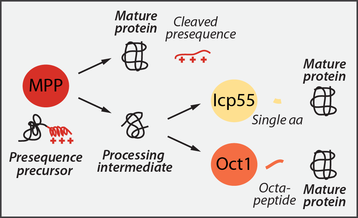P11: Proteases in mitochondrial protein quality control
Proteolysis in mitochondrial protein maturation and quality control (PI Nora Vögtle)
Mitochondrial proteases (mitoproteases) play a key role in the composition, maintenance and quality control of the mitochondrial proteome. Most mitoproteases are highly conserved from yeast to human and dysfunctions have been implicated in several diseases. Specialized mitoproteases termed presequence proteases are required for processing of presequences that are used as targeting signals by 70% of all mitochondrial proteins for import into the organelle after synthesis on cytosolic ribosomes. The essential mitochondrial processing protease (MPP) removes the presequence upon precursor translocation into the matrix. This first cleavage can generate mature proteins, but often results in unstable processing intermediates. Further processing by the intermediate cleaving peptidase Icp55 removing a single residue or the octapeptidyl aminopeptidase Oct1 removing an octapeptide is required to transform these processing intermediates into stable mature proteins. Why two proteases are required to cleave processing intermediates is currently not understood. Furthermore, it is not yet known if Icp55 has a similar function in higher eukaryotes.

ProtPath offers two topics for doctoral work on mitochondrial presequence proteases:
1) Crosstalk of the presequence proteases Icp55 and Oct1
Deletion of Icp55 and Oct1 causes a severe growth defect showing that both proteases together are essential to maintain functional mitochondria. We will use the model Saccharomyces cerevisiae to analyse the functional consequences of defective Icp55 and Oct1 processing using cell biological assays and mass spectrometry based approaches. The analysis of an Icp55-Oct1-crosstalk will reveal the functional dependence of presequence proteases on each other and their key role in maintaining the mitochondrial proteome.
2) Analysis of sequential cleavage in human mitochondria
The human homologue of Icp55 has not been characterized. We will use ICP55 knock-out cell lines to assess ICP55 function and investigate quality control by ICP55 in human cells. The focus will be on substrate identification using N-proteomics (together with Pitter Huesgen) and characterization of mitochondrial dysfunctions upon loss of ICP55. Mutations in ICP55 have also been linked to nephropathies and characterization of ICP55 knock-out cells and its substrate spectrum will be valuable to understand disease pathogenesis.

